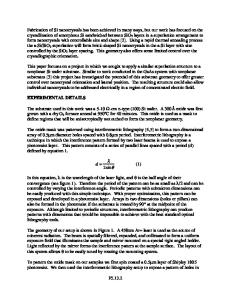Nanoscale Copper and Copper Compounds for Advanced Device Applications
- PDF / 1,597,960 Bytes
- 7 Pages / 593.972 x 792 pts Page_size
- 117 Downloads / 522 Views
COPPER has been in use for at least 10,000 years and was the first metal to be used in large quantity. Copper alloys, such as bronze and brass, have played important roles in advancing civilization in human history. Bronze artifacts date at least 6500 years. Early uses of bronze included tools, weapons, armor, and building materials since they are harder and more durable than their stone and copper predecessors. Brass is used for decoration for its bright gold-like appearance; for applications where low friction is required such as locks, gears, bearings, doorknobs, ammunition casings, and valves; for plumbing, electrical applications, and zippers. It has also been used extensively in brass musical instruments such as horns and bells where a combination of high workability and durability is desired. Brass is often used in situations where it is important that sparks should not be struck, as in fittings and tools around explosive gases. The ability to resist corrosion ensured that copper, bronze, and brass remained as both functional and decorative materials during the Middle Ages and the successive centuries through the Industrial Revolution and on to the present day.[1,2] The electrification of the world in late nineteenth century had resulted in the widespread use of Cu wires both for transmission of electricity and for coils in electrical motors. In fact, Cu is still mostly used as electrical wires (~60 pct) nowadays. The valuable properties of copper which were evident at the dawn of civilization were an attractive color, excellent ductility and malleability, and a capability of
being hardened by working. In modern times, further properties have been appreciated and exploited across a wide range of applications: high thermal and electrical conductivities, excellent corrosion and biofouling resistance, and antimicrobial properties. Historically, the Age of Cu Alloys gave way to the Age of Iron, not because of the lack of strength, but chiefly because of the economic factor. Owing to the present high price of the metal, Cu and its alloys are being replaced by cheaper materials, such as Al and plastics, in many applications.[1,2] It is of interest that in a compilation of end-use applications for Cu and Cu alloys in the United States, high electrical conductivity is the major reason for choosing copper and Cu alloys in 9 of 16 categories, corrosion resistance a major reason in 8, ease of fabrication in 6, and good heat-transfer properties in 5.[3] It is remarkable that in the Twenty-first century, Cu continues to find new ways into many main branches of technology. For example, Cu metallization in nanoelectronics devices, Cu oxide-based superconductors, Cu-In-Ga-Se (CIGS) solar materials, etc. Furthermore, discovery of intriguing properties and new applications in contemporary technology for copper and its compounds have continued. In this paper, we present several examples of nanoscale Cu and Cu compounds for advanced device applications.
II.
CU METALLIZATION
A. Interfacial Reactions
LIH-JUANN CHEN, Professor, is
Data Loading...











